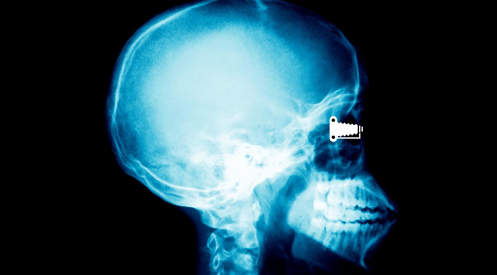08 Nov Micromáquinas

© Ruca
English Follows | Chinese Follows
Hace un tiempo, en el Stanford Research Institute, pude ver una demostración por el científico Roy Kornbluh (ver idea fuerza Homo Watt) de un prototipo de robot articulado, con el aspecto de una serpiente mecánica, cuyas articulaciones no eran servomotores (ruidosos y brillantes) sino que estaban construidas de músculo artificial, una especie de polímero que cambia de forma de acuerdo con la electricidad que recibe. La ?cosa? se movía y sonaba silenciosa como una serpiente, en efecto. Su función no era menos selvática: explorar las cloacas de las ciudades en busca de averías, que podían ser arregladas a distancia, gracias a las cámaras de vídeo y brazos artificiales instalables en su ?cuerpo?. Su forma articulada resultaba, obviamente, mucho más adecuada para esta función que un objeto de movimientos rectilíneos.
Veremos muchos de este tipo de aparatos, pequeños y especializados en tareas muy concretas. Y autónomos, energéticamente y navegacionalmente (determinaran cuál es el siguiente paso a tomar de acuerdo con la situación del terreno). Un ejemplo de robot doméstico (consumer robot) de este tipo lo tenemos ya en los aspiradores robot, aparatos que recorren autónomamente la casa en busca de polvo, que rebotan en las paredes, y que vuelven a la posición original en la que pueden conectarse al enchufe para recargar las baterías. (Ver el aspirador robot Roomba concebido y fabricado por iRobot o el Trilobite . Otro son los robots de planchado (ver Dressman de Siemens). Por no hablar de las mascotas mecánicas, como el Aibo de Sony.
En el mundo del gran consumo (detergentes, limpiadores, etc.), uno entrevé una tendencia de los fabricantes a aumentar sus márgenes a través de pequeños aparatos o gadgets (por ejemplo, vender un aparato para limpiar el coche a presión de agua combinada con jabón en lugar de vender sólo el jabón a litros, o una máquina para aplicarse el hilo dental. (P&G: el Mr.Clean AutoDry y el Oral-B Hummingbird).
El objetivo, hacernos pagar un diferencial por el cacharro, el ?gizmo?. La manera de hacerlo: vendernos pequeñas máquinas (micromáquinas) que suministren sustancias o hagan pequeños movimientos (delivery devices).
En otro orden de cosas, encontramos micromáquinas para la actividad industrial. Por ejemplo, pequeños helicópteros (como de modelismo) con cámaras para vigilar el estado de una cosecha (para tomar fotografías aéreas en diferentes zonas del espector electromagnético), o para vigilar fronteras, o el tráfico. Obviamente, lo primero que hemos visto de esto es en el campo militar: pequeños aviones o helicópteros (de unos 200 gramos de peso) que toman imágenes del campo enemigo (son tan pequeños que el enemigo ni los ve ni los detecta). Ver los UAVs (Unmanned Aerial Vehicles) de la empresa Aerovironment, o el Steadicopter israelí.
El futuro es de todo tipo de robots, pero, a corto plazo éstos serán pequeñas máquinas especializadas (micromáquinas), no robots con forma humanoide. A largo plazo, el futuro será de las nanomáquinas, máquinas con dimensiones en el dominio molecular o, incluso, atómico. Algún experto ha dicho que en robótica estamos hoy, comparativamente, como estaba la informática en 1978. (Sentencia de Rodney Brooks, director del Computer Science and Artificial Intelligence Laboratory del MIT, en un artículo suyo en Technology Review, Febrero de 2004, p30).
Tiempo al tiempo. El principal problema a resolver: la navegación autónoma, o sea, como la micromáquina ve por dónde va y por dónde debe ir, así como la capacidad de reacción a esas condiciones de entorno, en tiempo real.
Micromachines
Some time ago, I attended a scientific demonstration by Roy Kornbluh at the Stanford Research Institute (see the Homo Watt Power Idea) about a prototype articulated robot that looked like a mechanical snake, except that its joints were not noisy, shiny servo motors, but were made out of artificial muscle, a kind of polymer that changed shape depending on the electricity it received. This ‘animal’ moved around as silently as a snake. And its job was equally serpentine: to explore the jungle of city sewers in search of problems that could be fixed remotely, thanks to the video cameras and artificial arms fitted to its body. Its articulated body was clearly much better suited to this job than something that moved in only straight lines.
We shall see a lot of these small devices specially designed to perform very specific tasks. They are autonomous, in terms of both energy and navigation, since they decide their next step by assessing the situation on the ground. Consumer robots of this sort already exist in the form of robot vacuum cleaners, which automatically prowl the house hunting down dust, bounce off walls and come back to their starting point to plug themselves in and recharge their batteries. (See the Roomba robot vacuum cleaner, designed and manufactured by iRobot and the Trilobite from Electrolux. Another example is the robot iron (see Dressman from Siemens). Not to mention robot pets, such as the Aibo from Sony.
In a high-consumption world (detergents, cleaners, etc.), there is a clear trend for manufacturers to increase their profit margins by developing gadgets (e.g. selling a device to wash the car using a jet of water mixed with detergent, instead of only selling bottles of detergent, or a machine to apply dental floss. See P&G: the Mr. Clean AutoDry and the Oral-B Hummingbird.
The aim: to make us pay extra for the gizmo. How to do it: sell us micromachines to act as delivery devices (delivering substances or performing small movements).
We can also find micromachines at an industrial level. For instance, small helicopters (like model helicopters) fitted with cameras to monitor crops (by taking aerial photographs in different parts of the electromagnetic spectrum), borders or traffic. Clearly, this all has military origins: small planes and helicopters (weighing some 200g / 7oz.) which take images of enemy territory, and which are so small that the enemy doesn’t even see or detect them. See the UAVs (Unmanned Aerial Vehicles) from the company Aerovironment, and the Israeli Steadicopter.
The future lies with all kinds of different robots, but in the short term these will be small, specialised micromachines, rather than humanoids, robots with human form. In the long term, the future will lie with nanomachines with molecular, or even atomic, dimensions. Some experts have suggested that in the field of robotics, our time is like 1978 for home computers. (Rodney Brooks, Director of the Computer Science and Artificial Intelligence Laboratory at MIT, in an article written by him in Technology Review, February 2004, p30).
Biding our time. The main problem to be solved: autonomous navigation, i.e. the micromachine sees where it’s going and where it should go, as well as its response capabilities under those conditions in real time.
微型机器
日前,科学家罗伊‧孔布鲁 (Roy Kornbluh) 在斯坦福研究学院 (Stanford Research Institute) 证实 (参考何摩‧瓦特Homo Watt之 思想战力) 关节型机器人,即类似蛇形机器人,其关节不是像一般的电动服务器 (既声音吵杂又刺眼) 而是做成人造肌肉的样子,是一种聚合物且在电刺激下会产生移动。而该 ?人造肌肉?可移动且很安静,事实上好像蛇一般。它的功能有如蛇一样的灵活:它能检查城市中损坏的下水道,还可以在远处修复损坏的部份,这要感谢有录相机 设备以及装了人造手臂在它的 ?身体?中。关节部位则是直线移动装置,很明显地比以往的要来得更合适。
我们将会具体地看到这类小型且特别的器具,具有自动化、提高能源以及自动游走功能(人们一次性设定它的工作方式,一次性工作还是每天工作一次等等,每次工作在什么时刻,其余人们便不用管它),例如家用机器人(consumer robot) 这类型即所谓的机器人吸尘器,他们会在家中自动找寻灰尘, 一但碰触到墙壁会轻巧弹开,当吸尘器电力不足时或清洁任务完成自动返回基地台充电设备进行充电 ,(参看由 ?智能机器人技术公司〈 iRobot 〉? 设计制造的 ?伦巴智能机器人吸尘器 (Roomba)? 网站 或是瑞典家电厂商? ?伊莱克斯公司〈Electrolux〉? 所制造的 ?智能型吸尘器 (Trilobite)? 网站 。此外,其它像是烫衣机器人(请参看 ?西门子〈Siemens〉?研发的 ?人型烫衣机(Dressman)? 网站 Siemens)。以下就不赘述关于机械吉祥物例如索尼的爱宝机器狗 (Aibo)。
洗衣粉、清洁器等为目前世界上大量消费品,有人推测未来趋势,部分制造商则以生产小型装置或是新颖小机件来增加他们的利润 。(例如贩卖一种能喷出水和肥皂使汽车光洁干燥的电动喷枪,替代一般只能喷出肥皂水的系统;另外还有结合牙线的机器,请参看 ?宝洁公司〈P&G〉? 网页: ?汽车清洗系统 (Mr.Clean AutoDry)? 以及德国百灵 ?欧乐B蜂鸟电动牙线器 (Oral-B Hummingbird)? 。
最终目的,是让消费者购买各式各样的 ?小型产品?。其进行的方式为:让厂商贩卖给我们小型机器(微型机器) 用来提供物资或是作为派送装置 (delivery devices)用。
其它领域的产品,我们发现到微型机器也运用于工业用途,例如小直升机 (像模型一样大小) 装有摄相机来监视收成的情形 (即以电子侦查的方式在不同地方拍摄区域性的画面),或是视察边界、交通路况。很明显的,我们了解这是用于军事用途: 称做小飞机或是小直升机 (大约200公克的重量) 用来撷取敌方的影像 (因为体积非常的小,以至于敌人几乎看不到该机的侦查)。请参看 ?航宇环境公司〈Aerovironment〉? 有关 ?无人侦查机?–UAVs (Unmanned Aerial Vehicles) 或是以色列 ?自动直升机制造商 〈Steadicopter〉? 网站。
未来是机器人时代,不过短期内为专业的小型机器(微型机器), 而不是以类人类(humanoid)机器人的形式出现。但长远来看,将是以纳米机器人形式出现,此种机器是由纳米大小的微粒组成,即分子或甚至是原子 (Nanomachines)。一些专家提出,与1978年时的信息时代比起来,我们现在正处于机器人时代 (罗德尼‧布鲁克斯〈Rodney Brooks〉为麻省理工学院计算机科学暨人工智能实验室主任 〈Computer Science and Artificial Intelligence Laboratory〉其文章刊登于技术评论〈Technology Review〉2004年二月,请见第30页)。
随时间推移,有一个主要要解决的问题是:机械的自动游走问题。也就是说微型机器在有限的条件之下,要能同时具有方向判断及反应能力。



Sorry, the comment form is closed at this time.